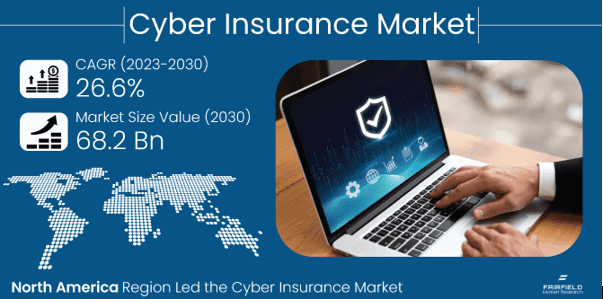Cyber Insurance Market : Shielding Businesses in the Digital Age

According to Fairfield Market Research, the global cyber insurance market is set to experience substantial growth over the next decade. The market size, valued at US$13.1 billion in 2022, is projected to soar to an impressive US$68.2 billion by the end of 2030. This significant increase is underpinned by a robust compound annual growth rate (CAGR) of 26.6% during the forecast period from 2023 to 2030.
Key Market Drivers: Increasing Use of Technology and Cyber Resilience Focus
Increasing Integration of Technology in Insurance Products
- The primary trend driving the cyber insurance market is the increasing integration of technology into insurance products. Insurers are utilizing telematics and IoT-enabled devices to monitor and evaluate cyber risks more effectively. These advanced devices are capable of gathering critical data on network security, identifying potential vulnerabilities, and providing actionable insights to mitigate these threats. By leveraging technology, insurers can offer more precise and comprehensive coverage, ensuring better protection against cyber incidents.
Growing Emphasis on Cyber Resilience
- Another significant trend is the growing emphasis on cyber resilience. Businesses are increasingly prioritizing strategies to maintain operations during and after cyber incidents. Cyber resilience involves preparing for, responding to, and recovering from cyber threats in a way that ensures the continuity of business operations. Cyber insurance plays a crucial role in this context by covering business interruption costs. This financial support allows companies to continue generating revenue even during recovery phases, thereby minimizing the impact of cyberattacks on their overall operations. By focusing on resilience, businesses can ensure long-term stability and operational efficiency despite the rising number of cyber threats.
For More Industry Insight:
https://www.fairfieldmarketresearch.com/report/cyber-insurance-market
Enterprise and Healthcare Sectors: Key Contributors
Large enterprises led the market in 2022, driven by their substantial data volumes and higher premiums. Insurers offer tailored coverage options to attract large businesses, providing innovative solutions to meet their specific needs.
The healthcare sector is anticipated to experience the fastest growth. The increasing use of connected medical devices raises cybersecurity risks. Insurance policies in this sector cover financial impacts resulting from device-related breaches, ensuring healthcare organizations can manage cyber threats effectively.
Regional Insights: North America and Asia Pacific
North America is expected to dominate the cyber insurance market throughout the forecast period. The region’s leading insurers are introducing advanced coverage options to address emerging cyber risks associated with technologies like cloud computing, IoT, and AI. The U.S., with its stringent cybersecurity regulations and government oversight, holds the largest share in the region.
Asia Pacific is projected to be the fastest-growing region. Businesses in emerging economies are increasingly adopting cyber insurance to protect their digital assets and reputation. Countries like Japan, Singapore, Indonesia, and Malaysia are witnessing significant increases in cyberattacks, driving the demand for cyber insurance solutions.
Comparative Analysis: Historical and Future Trends
During the historical period of 2018 – 2022, the market witnessed staggered growth. The proliferation of mobile devices expanded the attack surface for cybercriminals, leading to increased demand for cyber insurance. The rise in mobile payment transactions and BYOD policies further emphasized the need for comprehensive cybersecurity measures.
In the coming years, data protection laws and international regulations will play a crucial role in shaping the market. Cyber insurance will help businesses manage compliance costs and mitigate financial risks associated with regulatory penalties and legal fees.
Growth Determinants: Evolving Cybercrime Threats and Business Awareness
The growing frequency and sophistication of cyberattacks, such as data breaches, ransomware, and phishing scams, are driving businesses to adopt cyber insurance as a critical component of their risk management strategies. The financial losses resulting from these attacks, including data recovery, system restoration, and legal expenses, highlight the importance of cyber insurance.
Businesses are increasingly recognizing the significance of cyber insurance in mitigating financial losses from data breaches. Regulatory penalties for data protection violations further incentivize organizations to invest in cyber insurance to offset potential liabilities.
Opportunities and Trends: Data Analytics and Cybersecurity Risk Management
Data Analytics for Cybersecurity:
- Insurance companies are increasingly leveraging data analytics to provide their policyholders with valuable insights into improving their cybersecurity defenses. By analyzing data, insurers can help organizations identify vulnerabilities and implement stronger security measures.
- This proactive approach not only helps businesses enhance their security posture but also ensures that their cybersecurity practices are in line with industry standards and regulatory requirements.
- As a result, companies that adopt these improved practices may benefit from reduced insurance costs, as they present a lower risk to insurers.
Cybersecurity Risk Management:
- Effective cybersecurity risk management is becoming a critical component of business continuity planning. Companies must prepare for potential cyber incidents and have strategies in place to mitigate their impact.
- Cyber insurance plays a vital role in this process by covering costs associated with business interruptions caused by cyber incidents. This coverage helps ensure that businesses can maintain financial stability and continue operations during the recovery phase.
- By incorporating cybersecurity risk management into their overall business strategy, organizations can better protect themselves against the financial and operational disruptions that cyber threats can cause.
Challenges: Premium Costs and Risk Assessment
High premium costs pose a challenge for small and medium-sized enterprises (SMEs), limiting their ability to invest in cyber insurance. The variability in premiums based on industry, business size, and claim history makes it difficult for companies to budget for cyber insurance expenses.
The abstract nature of cyber risks complicates risk assessment for insurers. The lack of historical data and the dynamic nature of cyber threats hinder accurate prediction of potential losses, making it challenging to develop effective actuarial models.
Competitive Landscape: Leading Players in the Cyber Insurance Market
The cyber insurance market is highly competitive, with major players focusing on expanding distribution networks, introducing new products, and enhancing business practices. Key market participants include:
- Travelers Company
- AXA XL
- Chubb
- American International Group, Inc.
- Beazley Group
- AXIS Capital Holdings Limited
- CNA Financial Corporation
- BCS Financial Corporation
- The Hanover Insurance, Inc.
- Zurich Insurance
- Berkshire Hathaway Inc.
- Munich Re
- Lloyd’s of London Ltd
- Aon plc
- Lockton Companies, Inc.
About Us
Fairfield Market Research is a UK-based market research provider. Fairfield offers a wide spectrum of services, ranging from customized reports to consulting solutions. With a strong European footprint, Fairfield operates globally and helps businesses navigate through business cycles, with quick responses and multi-pronged approaches. The company values an eye for insightful take on global matters, ably backed by a team of exceptionally experienced researchers. With a strong repository of syndicated market research reports that are continuously published & updated to ensure the ever-changing needs of customers are met with absolute promptness.





